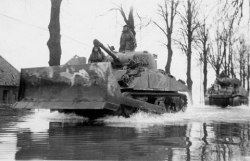
A German opinion on the Sherman (Jentz’s Panzer Truppen, Vol. 2, p.150-151):
The preferences of the crews for lighter, more manoeuvrable Panzers was recorded in a report written on November 1944 by Albert Speer on his trip to Italy during 19 to 25 October 1944:
“On the Southwest Front, opinions are in favor of the Sherman tank and its cross-country ability. The Sherman tank climbs mountains that our Panzer crews consider impassable. This is accomplished by the especially powerful engine in the Sherman in comparison to its weight. Also, according to reports from the 26.Panzer-Division, the terrain-crossing ability on level ground (in the Po valley) is completely superior to our Panzers. The Sherman tanks drive freely cross-country, while our Panzers must remain on trails and narrow roads and therefore are very restricted in their ability to fight.
All Panzer crews want to receive lighter Panzers, which are more maneuverable, possess increased ability to cross terrain, and guarantee the necessary combat power just with a superior gun. This desire by the troops corresponds with conditions that will develop in the future as a result of the drop in production capacity and of the fact that, because of a shortage of chrome, sufficient armor plate can’t be produced to meet the increased production plans. Therefore, either the number of Panzers produced must be reduced or it will be necessary to reduce the thickness of the armor plate. In that case, the troops will unequivocally ask for a reduction of the armor thickness in order to increase the total number of Panzers produced.”
The M4 pilot model was built by Lima Locomotive works in February 1941, differing from the T6 principally in the elimination of the hull side doors. Full production in three plants, Lima, Pressed Steel, and Pacific Car & Foundry started the following month, all these initial production types being cast hull vehicles, designated M4Al. By the autumn of 1942 all other plants in the programme were in full production, and in October 1942, at the Battle of Alamein, the first M4 mediums went into action with British forces. The M4 series was the most widely produced, most widely used, and most important of all tanks in service with American, British, and allied forces in World War II. While not necessarily the best Allied tank in qualitative terms, and certainly inferior in armour and hitting power to the best German and Soviet tanks, the M4 medium tank (popularly known by its British name of Sherman) had the virtues of simplicity of maintenance, reliability, speed, ruggedness, and an uncomplicated design. These were most important factors for a vehicle being mass-produced in commercial plants with no background of military experience in peace-time, for use largely by conscript troops with training time limited by the needs of war. In terms of cost-effectiveness, the M4 Sherman was supremely suited to the needs of the hour, a fact reflected in the total output of more than 40,000 tanks (and associated AFVs) based on the M4 chassis in the years 1942-46. Shermans were used by every allied nation in every armour role on every fighting front.
The Medium Tank M4 had the same basic chassis as the M3 medium, with vertical volute suspension, rear engine, and front drive. Apart from very early models, the bogies were altered, however, so that the return rollers were set behind, instead of on top of, the spring units. Hull was either welded, cast, or welded with cast/rolled nose, as detailed in descriptions of the different models, while the 75mm gun was set in a simple cast turret and provided with a gyro-stabiliser as in the M3. Initially the engine was a Continental R-975 air-cooled radial type, but an ever-persistent shortage of this Wright-built power unit (which was essentially an aircraft engine and needed as such by the aero industry) forced the adoption of alternative engines, giving rise to the main production variants. The M4 Sherman had a five man crew, could fire AP or HE shot, had a maximum armour thickness of 50mm (more on reworked and late models), had controlled differential steering, weighed from 33 (short) tons, gross, and had a top speed of 24-30mph according to model. There were numerous detail changes in models during their production life and these are detailed for individual types.